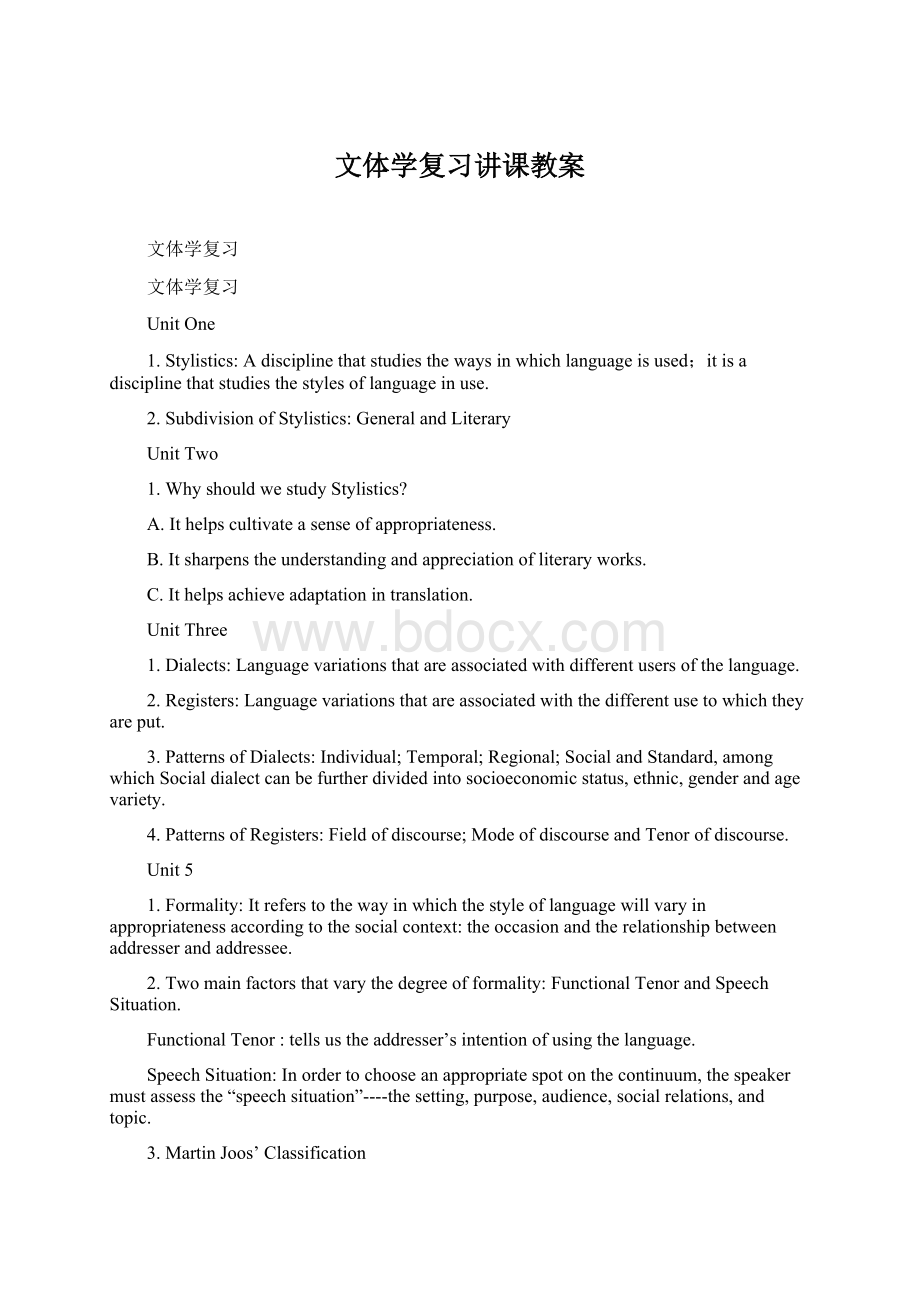文体学复习讲课教案.docx
《文体学复习讲课教案.docx》由会员分享,可在线阅读,更多相关《文体学复习讲课教案.docx(9页珍藏版)》请在冰豆网上搜索。

文体学复习讲课教案
文体学复习
文体学复习
UnitOne
1.Stylistics:
Adisciplinethatstudiesthewaysinwhichlanguageisused;itisadisciplinethatstudiesthestylesoflanguageinuse.
2.SubdivisionofStylistics:
GeneralandLiterary
UnitTwo
1.WhyshouldwestudyStylistics?
A.Ithelpscultivateasenseofappropriateness.
B.Itsharpenstheunderstandingandappreciationofliteraryworks.
C.Ithelpsachieveadaptationintranslation.
UnitThree
1.Dialects:
Languagevariationsthatareassociatedwithdifferentusersofthelanguage.
2.Registers:
Languagevariationsthatareassociatedwiththedifferentusetowhichtheyareput.
3.PatternsofDialects:
Individual;Temporal;Regional;SocialandStandard,amongwhichSocialdialectcanbefurtherdividedintosocioeconomicstatus,ethnic,genderandagevariety.
4.PatternsofRegisters:
Fieldofdiscourse;ModeofdiscourseandTenorofdiscourse.
Unit5
1.Formality:
Itreferstothewayinwhichthestyleoflanguagewillvaryinappropriatenessaccordingtothesocialcontext:
theoccasionandtherelationshipbetweenaddresserandaddressee.
2.Twomainfactorsthatvarythedegreeofformality:
FunctionalTenorandSpeechSituation.
FunctionalTenor:
tellsustheaddresser’sintentionofusingthelanguage.
SpeechSituation:
Inordertochooseanappropriatespotonthecontinuum,thespeakermustassessthe“speechsituation”----thesetting,purpose,audience,socialrelations,andtopic.
3.MartinJoos’Classification
A.thefrozenlevel:
writtenlegaldocumentsorhighlysolemnspeech.
B.theformallevel:
usedforpublicaddresssuchaslecturesorspeecheswheretheaudienceisnotknowntothespeakerpersonallyorwherepersonalacquaintanceisnotacknowledged.
C.theconsultativelevel:
Lessformalgatheringssuchascommitteemeetingswherestatusisstillfairlyclearlydesigned,butwhereparticipantsinteract.
D.thecasuallevel:
Amongfriends,orpeerswhoknoweachotherwellenoughthatlittleelaborationisnecessary.
E.theintimatelevel:
betweenpeoplewhoseeeachotherdailyandsharethemajorityoftheirdailylifeexperiences.
Unit6
1.Distinctionsamongspeech:
Speechcanbespontaneous(conversingv.monologuing)andnon-spontaneous(sub-categorizedasreciting).
2.Distinctionsamongwriting:
Thetextthathasbeenwrittenmaybewrittentobespokenasifnotwritten(thelinesinadrama),writtentobespoken(scriptsforsermons,speeches,lectures,newsbulletinsandcommentaries),orevenwrittennotnecessarilytobespokenwithnorelationtothespokenmode(telephonebookordictionaries),andwrittennotnecessarilytobespokenbutwitharelationshipwiththespokenmode(dialogueinanovel).
Unit7Conversation
1.Grammaticalfeaturesofconversation
A.preferenceforshortandloosesentences
B.highincidenceofellipticalandincompletesentences
C.frequencyofinterrogativesentences
D.simplenominalandverbalgroupstructure
2.Lexicalfeatures
A.preferenceforshortwordsandvagueexpression
B.frequentuseofcolloquialitemsandidiomsandagreatmanyphrasalverbs
C.useoflexicalhyperboleandofslang
3.Phonologicalfeatures
A.frequentuseofsomebasicprosodicpattern(Thereisahighproportionofsimplefallingtones.)
B.prosodicvariationwithinthetone-unit
C.frequencyofpauseanduneventempo
D.freeoccurrenceofparalinguisticeffects
4.Semanticfeatures
A.randomnessofsubjectmatterandgenerallackofplanning
B.cohesivedeviceisverymarkedbythefrequentuseofpersonalpronounreference,cross-referenceusingarticlesanddeterminersanduseofcoordinatingconjunction.
Unit8PublicSpeech
1.Grammaticalfeaturesofpublicspeech
A.variationinsentencelength,asitreflectstheemotionalstateofmindofthespeakerandhis/herefforttoevokeanactiveresponsefromtheaudience.
B.varioussentencetypes(mostofthemarestatements,occasionalquestionsareused;vocativesareusedtoaddatouchofintimacytotheaddresser-addresseerelationship)
C.morecomplex-lookinggroupstructures(nominalgroupsaremorewithpostmodificationthanwithpremodification.
2.Lexicalfeatures
A.usingaccurateandcleanwords(muchuseofabstractwordsorevenbigwords)
B.adaptationofwordingtoparticularaudience
C.lessuseofphrasalverbs
3.Phonologicalfeatures
A.appropriatevolumeandpitchvariation
B.varyingtempoandrightlytimepause
C.rhythmiceffect
D.distinctarticulation
E.fulluseofnon-verbalcommunication
4.semanticfeatures
A.effectivewaysoforganization(problem-solutionorder)
Fivestepsofpsychologyofpersuasion:
Attention-Need-Satisfaction-Visualization-Action.
Connectivesinpublicspeaking:
theuseoftransitionalphrases,internalpreviewsandsummaries,andtheuseofsignposts
B.effectivewaysofdelivery
parallelism:
makesthestatementclear,consis